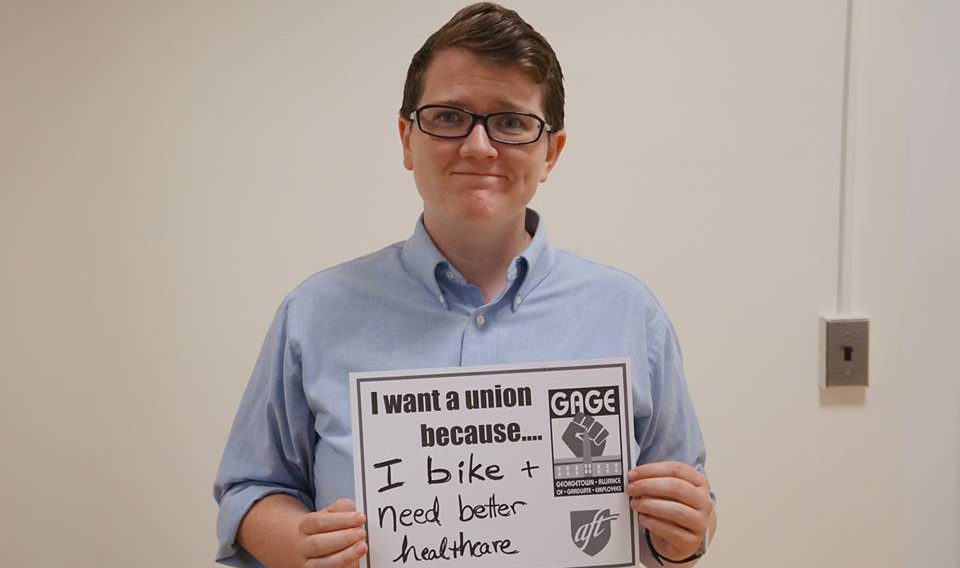
WASHINGTON—In a reversal from its action of just two weeks before with another group of workers, the management of Georgetown University refused to voluntarily recognize the union, the American Federation of Teachers, which a majority of its hundreds of research assistants and teaching assistants want.
The Dec. 6 letter to the RAs and TAs, from university Provost Robert Groves comes barely two weeks after another group of Georgetown workers, its 500 adjunct professors, ratified their second contract with the institution.
Groves’ letter prompted a peaceful on-campus protest Dec. 7 by the RAs and TAs, organized as the Georgetown Association of Graduate Employees (GAGE).
Meanwhile, voting Georgetown adjuncts ratified their pact by a 2-10-1 ratio, said Anne McLeer, director of higher education for Service Employees Local 500, which represents them.
Almost simultaneously, her local won a union recognition vote, also by a 2-to-1 ratio, among 135 adjunct faculty at another D.C.-area university, Howard, a flagship among the nation’s historically black colleges and universities.
The Teachers’ unionization drive among Georgetown’s RAs and TAs has been going for almost a year. It started more than 18 months ago as an independent effort with a smaller goal: to increase the TAs’ and RAs’ stipends when the university wanted just to increase their hours. Then it expanded.
Like similar successful drives among RAs and TAs at other prestigious private universities – such as the University of Chicago and Columbia – key issues are lack of respect for the work the RAs and TAs perform, low stipends, lack of job security and skimpy benefits.
Like most of those other universities, Georgetown’s management argues the TAs and RAs are “students,” and not organizable under labor law. Georgetown characterizes the relationship as “mentor” and “mentee.”
That’s what Groves wrote to them, standing on a George W. Bush-era National Labor Relations Board ruling. But a 2016 NLRB ruling reversed that precedent, ruling TAs and RAs at private universities are “employees” under labor law, and have the right to organize.
The decision lets RAs and TAs add themselves to adjunct professors, fast-food workers, retail workers, port truck drivers, airport workers and warehouse workers in the nationwide movement of low-paid workers who have hit the streets in the past few years under the general name of the “Fight for 15 and a union” campaign.
That drive demands decent pay and the right to organize without bosses’ interference, intimidation, harassment and illegal firings.
Low pay is a big issue for the Georgetown TAs and RAs. History PhD Ben Feldman e-mailed the student newspaper that most Georgetown TAs and RAs receive a $27,000 yearly stipend, below the current living wage for a single person in D.C. The RAs and TAs’ health care coverage is identical to that for undergrads, though the RAs and TAs, who are older, have different health needs and costs.
“A union will help us negotiate for a living wage, as well as access to dental, vision, and mental health care,” Feldman told the student paper.
Meanwhile, Local 500 reported Georgetown’s 500 adjuncts just ratified their second contract, while the 135 adjuncts at Howard voted for the union.
The Howard vote is significant, McLeer said, because tenure – or lack of it – was the key issue. Unlike past decades, in recent years, universities have been very skimpy in granting tenure and more than half of all U.S. college and university faculty members now lack it, and lack job security as a result.
“They’re facing a future with no tenure, so they see organizing a union as a way to get stability on the job,” she added.
That stability brought the 500 adjuncts at Georgetown a second contract with Local 500, while Georgetown said the pact is in line with its commitment to Catholic social justice values, announced in its 10-year-old Just Employment Policy.
It didn’t mention that policy, though, in Groves’ letter to Georgetown’s TAs and RAs. But Groves also sent a warning letter to faculty, telling them what they could and could not do, under labor law, in responding the TAs, RAs and their unionization drive.
The “do nots” were a lot more extensive. They included banning faculty from discriminating against pro-union RAs and TAs, quizzing them about the union, threatening them with loss of jobs or funding, giving the impression of surveillance – or actually doing so – and asking the RAs and TAs to “report back on what the union representatives said.”
The Georgetown adjuncts’ new contract includes “a nearly 50 percent increase in the minimum rate per course by fall 2019,” to “$7,000 for a three-credit course” then “while enabling many adjuncts to continue to be paid well in excess of this,” Groves announced.
The new pact also includes extra hikes for the lowest-paid adjuncts and longest-serving adjuncts, and a joint union-management committee to try to work out a new structure that would give Georgetown adjuncts more job security.
CORRECTION: An earlier version of this story inaccurately listed Brown University as one of the institutions at which a unionization drive had successfully taken place.












Comments